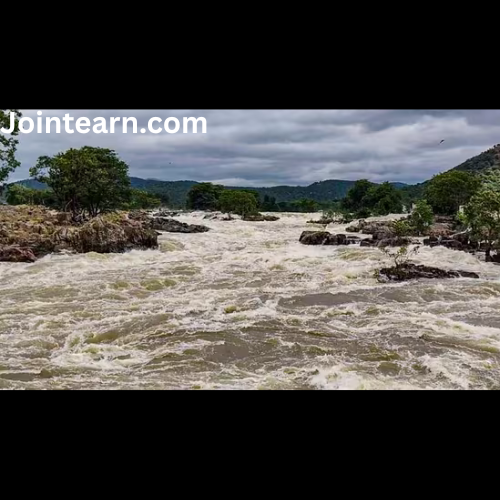
A deep depression over the southeast and adjoining west-central Bay of Bengal is intensifying, prompting authorities in several Indian states to prepare for a severe cyclonic storm, which has been named Cyclone Montha. According to the India Meteorological Department (IMD), the system is moving west-northwestwards and is expected to strengthen into a cyclonic storm by October 27, with further intensification into a “severe cyclonic storm” by the morning of October 28. The cyclone is projected to make landfall along the Andhra Pradesh coast, particularly between Machilipatnam and Kalingapatnam near Kakinada, bringing gusty winds of 90–100 kmph, with gusts potentially reaching 110 kmph.
The Indian Army has been placed on high alert to assist in disaster management and relief operations. Coordination is ongoing with the National Disaster Management Authority (NDMA) and respective state governments to ensure preparedness and rapid response. The southern peninsula, including Andhra Pradesh, Telangana, Tamil Nadu, and Odisha, is expected to bear the brunt of the storm. Red alerts have been issued for Andhra Pradesh (October 27–29), Odisha (October 28–29), and Telangana and Chhattisgarh (October 28). Tamil Nadu has been placed under an orange alert for October 27 and 28.
Rainfall forecasts indicate heavy to very heavy precipitation in multiple regions. Coastal Andhra Pradesh and Yanam are expected to see widespread rainfall from October 26–30, with extremely heavy showers between October 27–29. Telangana is expected to witness heavy to very heavy rainfall from October 27–30, peaking on October 28. Rayalaseema will experience heavy rain on October 27 and 28, while coastal and interior Karnataka are likely to see moderate rainfall with isolated heavy spells from October 26–28.
Odisha is forecast to receive heavy to very heavy rainfall from October 27–30, with isolated extremely heavy rain over south Odisha on October 28 and 29. Chhattisgarh is expected to experience similar precipitation patterns, with extremely heavy rainfall on October 28. Eastern and western Madhya Pradesh will see isolated heavy rainfall from October 26–30, accompanied by thunderstorms and gusty winds. Vidarbha is expected to receive heavy rain from October 28–30, particularly intense on October 28. Bihar and Jharkhand are likely to experience light to moderate rain from October 29–31, while Gangetic West Bengal and Sub-Himalayan West Bengal/Sikkim may see rain from October 28–31, increasing toward the end of the month.
In western India, the deep depression over the Arabian Sea continues to influence weather patterns. Konkan and Goa are expected to receive heavy rainfall on October 26 and 27, along with thunderstorms and gusty winds of 40–50 kmph. Madhya Maharashtra will also see heavy rainfall on October 26, while Gujarat, Saurashtra, and Kutch will experience rain from October 26–30, including isolated very heavy rainfall on October 26 and 27.
The Andhra Pradesh government has already readied an action plan to manage relief and essential supplies in anticipation of Cyclone Montha. Civil supplies minister N. Manohar confirmed that stockpiles of Public Distribution System (PDS) commodities, fuel inventories, and food supplies for relief shelters have been prepared, along with measures for post-cyclone relief distribution.
The name “Montha” was submitted by Thailand and is part of the pre-approved roster of names for tropical cyclones in the North Indian Ocean region, as maintained by the World Meteorological Organisation (WMO) and the United Nations Economic and Social Commission for Asia and the Pacific (ESCAP) Panel on Tropical Cyclones. In Thai, “Montha” reportedly means “fragrant flower” or “beautiful flower.”
The IMD has also issued warnings regarding sea conditions. Very rough to high seas are expected across the southeast and east-central Bay of Bengal starting October 26 evening, turning high to very high over the west-central and northwest Bay by October 27 evening, lasting through the morning of October 29. Coastal waters along Tamil Nadu-Puducherry, Andhra Pradesh-Yanam, and Odisha are expected to experience rough to very rough conditions, which will become very high in certain areas during peak periods, with gradual improvement thereafter.
Residents along the projected path of Cyclone Montha have been urged to remain indoors, avoid travel, and follow directives from local authorities. The Indian Army and disaster management teams are prepared for rapid deployment to assist affected populations, clear debris, restore infrastructure, and provide emergency supplies. Communities in Andhra Pradesh and Odisha, particularly in low-lying coastal areas, have been advised to evacuate to safer locations ahead of the cyclone’s landfall.
Cyclone Montha underscores the vulnerability of the eastern and southern coasts of India to intense weather systems during the post-monsoon period. With climate variability contributing to the increasing intensity of cyclonic storms, meteorological authorities continue to emphasize timely warnings, preparedness, and public awareness campaigns to reduce casualties and damage to property.
In addition to Cyclone Montha, a depression persists over the east-central Arabian Sea, moving southwest at approximately 13 kmph. Positioned roughly 760 km west-southwest of Mumbai, 790 km west of Goa, and 970 km west-northwest of Mangalore as of October 26 morning, this system could influence rainfall patterns over western India, although no intensification into a cyclonic storm has been indicated by the IMD.
As the situation develops, continuous monitoring of both the Bay of Bengal and Arabian Sea systems remains critical. Meteorologists and state authorities have urged fishermen to avoid venturing into the sea, while residents of vulnerable districts are advised to remain alert to updated forecasts and emergency advisories. Coordination between state administrations, the NDMA, and central forces like the Indian Army will be vital in mitigating the impact of Cyclone Montha on lives, livelihoods, and infrastructure.
In summary, Cyclone Montha is expected to make landfall along the Andhra Pradesh coast by the evening or night of October 28 as a severe cyclonic storm, bringing heavy to very heavy rainfall, strong winds, and rough sea conditions across multiple states. With red alerts in Andhra Pradesh, Odisha, Telangana, and Chhattisgarh, and extensive preparedness measures underway, the government and disaster response agencies are focused on ensuring public safety and minimizing damage caused by the storm.


Leave a Reply